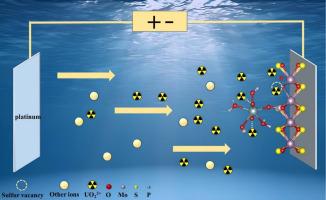Synergistic phosphoryl group and sulfur vacancy engineering on MoS₂ nanosheets for highly efficient electrochemical uranium extraction
IF 9.8
1区 工程技术
Q1 ENGINEERING, CHEMICAL
引用次数: 0
Abstract
Extracting uranium from nuclear wastewater is critical for environmental protection and sustainable nuclear energy. Conventional electrochemical methods suffer from limited adsorption capacity and slow kinetics. In this work, phosphorus-oxygen co-doped MoS₂ nanosheets with sulfur vacancies were designed and synthesized as an advanced electrode material. Synergistic effects from phosphoryl groups and sulfur vacancies enhance uranyl ion capture via coordination, electrostatic attraction, and electrochemical reduction. At −0.9 V applied potential, PO-MoS₂ achieves a high adsorption capacity of 501.79 mg g−1, significantly exceeding the 120.85 mg g−1 of O-MoS₂ at pH=5.0, and removes 99.5 % U (VI) within 20 min. The material retains over 82.0 % efficiency after 6 cycles. Mechanistic studies confirm U(VI) reduction to insoluble U(IV) species, while density functional theory calculations validate strong uranyl ions -phosphoryl coordination. This strategy provides a high-performance electrode for efficient uranium extraction.

mos2纳米片协同磷酰基和硫空位工程用于高效电化学提铀
从核废水中提取铀对环境保护和核能可持续发展至关重要。传统的电化学方法存在吸附能力有限、动力学慢的缺点。本文设计并合成了含硫空位的磷氧共掺杂MoS 2纳米片作为一种先进的电极材料。磷酰基和硫空位的协同作用通过配位、静电吸引和电化学还原增强了铀酰离子的捕获。在−0.9 V电位下,PO-MoS 2达到501.79 mg g−1的高吸附量,显著超过pH=5.0时O-MoS 2的120.85 mg g−1,并在20 min内去除99.5%的U (VI)。经过6次循环后,该材料的效率保持在82.0%以上。机制研究证实了U(VI)还原为不溶性U(IV),而密度泛函理论计算证实了铀酰离子与磷酰的强配位。该策略为高效提取铀提供了一种高性能电极。
本文章由计算机程序翻译,如有差异,请以英文原文为准。
求助全文
约1分钟内获得全文
求助全文
来源期刊

Desalination
工程技术-工程:化工
CiteScore
14.60
自引率
20.20%
发文量
619
审稿时长
41 days
期刊介绍:
Desalination is a scholarly journal that focuses on the field of desalination materials, processes, and associated technologies. It encompasses a wide range of disciplines and aims to publish exceptional papers in this area.
The journal invites submissions that explicitly revolve around water desalting and its applications to various sources such as seawater, groundwater, and wastewater. It particularly encourages research on diverse desalination methods including thermal, membrane, sorption, and hybrid processes.
By providing a platform for innovative studies, Desalination aims to advance the understanding and development of desalination technologies, promoting sustainable solutions for water scarcity challenges.
 求助内容:
求助内容: 应助结果提醒方式:
应助结果提醒方式:


